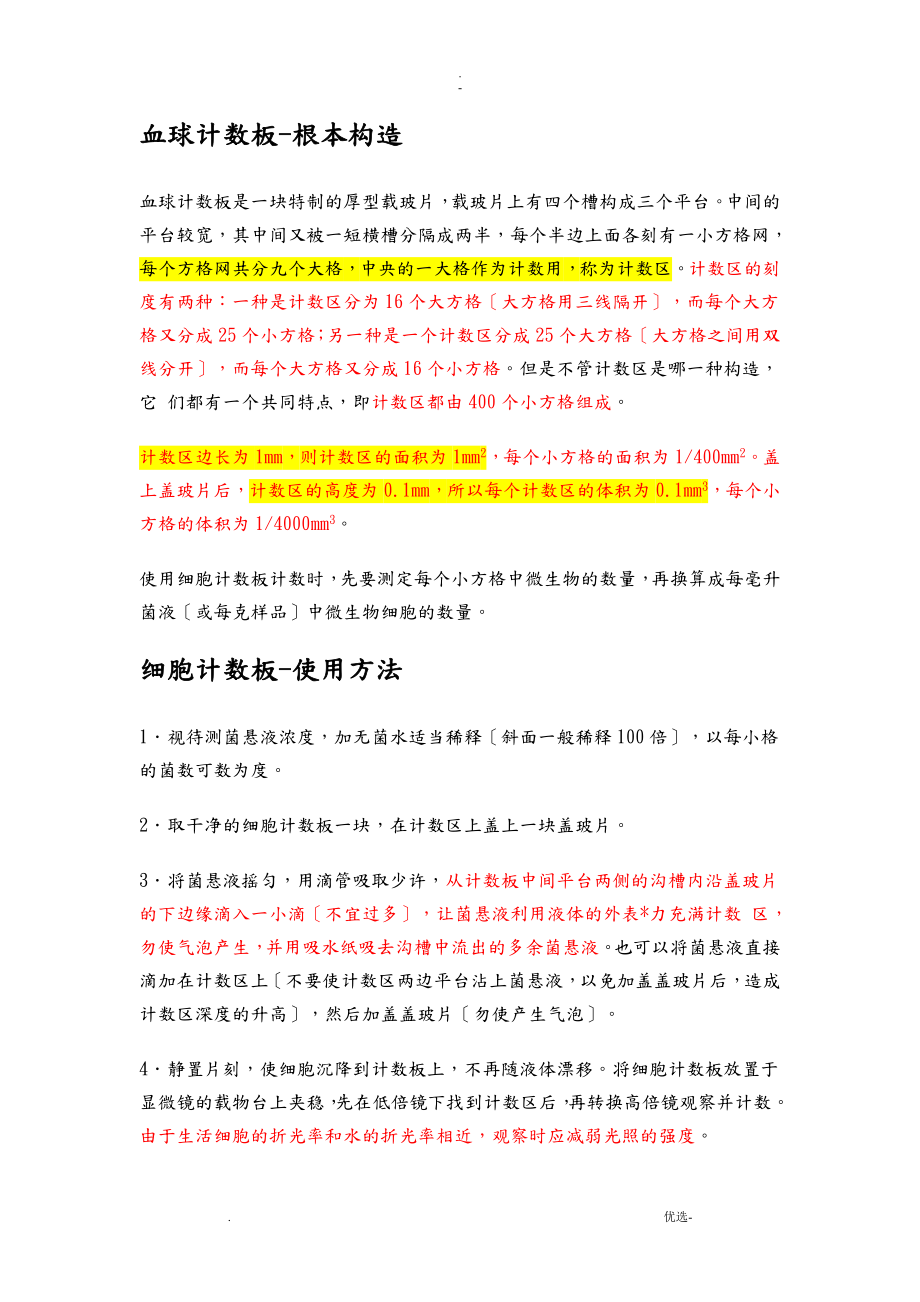 细胞计数板的使用方法
细胞计数板的使用方法



《细胞计数板的使用方法》由会员分享,可在线阅读,更多相关《细胞计数板的使用方法(6页珍藏版)》请在装配图网上搜索。
1、. -血球计数板-根本构造血球计数板是一块特制的厚型载玻片,载玻片上有四个槽构成三个平台。中间的平台较宽,其中间又被一短横槽分隔成两半,每个半边上面各刻有一小方格网,每个方格网共分九个大格,中央的一大格作为计数用,称为计数区。计数区的刻度有两种:一种是计数区分为16个大方格大方格用三线隔开,而每个大方 格又分成25个小方格;另一种是一个计数区分成25个大方格大方格之间用双线分开,而每个大方格又分成16个小方格。但是不管计数区是哪一种构造,它 们都有一个共同特点,即计数区都由400个小方格组成。计数区边长为1mm,则计数区的面积为1mm2,每个小方格的面积为1/400mm2。盖上盖玻片后,计数区
2、的高度为0.1mm,所以每个计数区的体积为0.1mm3,每个小方格的体积为1/4000mm3。使用细胞计数板计数时,先要测定每个小方格中微生物的数量,再换算成每毫升菌液或每克样品中微生物细胞的数量。细胞计数板-使用方法1视待测菌悬液浓度,加无菌水适当稀释斜面一般稀释100倍,以每小格的菌数可数为度。2取干净的细胞计数板一块,在计数区上盖上一块盖玻片。3将菌悬液摇匀,用滴管吸取少许,从计数板中间平台两侧的沟槽内沿盖玻片的下边缘滴入一小滴不宜过多,让菌悬液利用液体的外表*力充满计数 区,勿使气泡产生,并用吸水纸吸去沟槽中流出的多余菌悬液。也可以将菌悬液直接滴加在计数区上不要使计数区两边平台沾上菌悬
3、液,以免加盖盖玻片后,造成 计数区深度的升高,然后加盖盖玻片勿使产生气泡。4静置片刻,使细胞沉降到计数板上,不再随液体漂移。将细胞计数板放置于显微镜的载物台上夹稳,先在低倍镜下找到计数区后,再转换高倍镜观察并计数。由于生活细胞的折光率和水的折光率相近,观察时应减弱光照的强度。5计数时假设计数区是由16个大方格组成,按对角线方位,数左上、左下、右上、右下的4个大方格即100小格的菌数。如果是25个大方格组成的计数区,除数上述四个大方格外,还需数中央1个大方格的菌数即80个小格。为 了保证计数的准确性,防止重复计数和漏记,在计数时,对沉降在格线上的细胞的统计应有统一的规定。如菌体位于大方格的双线上
4、,计数时则数上线不数下线,数 左线不数右线,以减少误差。即位于本格上线和左线上的细胞计入本格,本格的下线和右线上的细胞按规定计入相应的格中。见以下列图:即本格中计数细胞为3个。细胞压线,仅计数相邻的两条线上的细胞6对于出芽的酵母菌,芽体到达母细胞大小一半时,即可作为两个菌体计算。每个样品重复计数2-3次每次数值不应相差过大,否则应重新操作,按公式计算出每mLg菌悬液所含细胞数量。7测数完毕,取下盖玻片,用水将细胞计数板冲洗干净,切勿用硬物洗刷或抹擦,以免损坏网格刻度。洗净后自行晾干或用吹风机吹干,放入盒内保存。细胞计数板-计数公式1、16格25格的细胞计数板计算公式:细胞数/ml=100小格内
5、细胞个数/10040010000稀释倍数1、25格16格的细胞计数板计算公式:细胞数/ml=80小格内细胞个数/8040010000稀释倍数网摘:blog.tianya./blogger/post_read.aspBlogID=1766764&PostID=17108229之前写的细胞计数板使用,其中的图片天涯都给删了,我没有备份。今天浏览网页看到一个英文版的介绍,写的很好。Using a Counting ChamberFor microbiology, cell culture, and many applications that require use of suspensions o
6、f cells it is necessary to determine cell concentration. One can often determine cell density of a suspension spectrophotometrically, however that form of determination does not allow an assessment of cell viability, nor can one distinguish cell types.A device used for determining the number of cell
7、s per unit volume of a suspension is called a counting chamber. The most widely used type of chamber is called a hemocytometer, since it was originally designed for performing blood cell counts. To prepare the counting chamber the mirror-like polished surface is carefully cleaned with lens paper. Th
8、e coverslip is also cleaned. Coverslips for counting chambers are specially made and are thicker than those for conventional microscopy, since they must be heavy enough to overe the surface tension of a drop of liquid. The coverslip is placed over the counting surface prior to putting on the cell su
9、spension. The suspension is introduced into one of the V-shaped wells with a pasteur or other type of pipet. The area under the coverslip fills by capillary action. Enough liquid should be introduced so that the mirrored surface is just covered. The charged counting chamber is then placed on the mic
10、roscope stage and the counting grid is brought into focus at low power.It is essential to be e*tremely careful with higher power objectives, since the counting chamber is much thicker than a conventional slide. The chamber or an objective lens may be damaged if the user is not not careful. One entir
11、e grid on standard hemacytometers with Neubauer rulings can be seen at 40* (4* objective). The main divisions separate the grid into 9 large squares (like a tic-tac-toe grid). Each square has a surface area of one square mm, and the depth of the chamber is 0.1 mm. Thus the entire counting grid lies
12、under a volume of 0.9 mm-cubedSuspensions should be dilute enough so that the cells or other particles do not overlap each other on the grid, and should be uniformly distributed. To perform the count, determine the magnification needed to recognize the desired cell type. Now systematically count the
13、 cells in selected squares so that the total count is 100 cells or so (number of cells needed for a statistically significant count). For large cells this may mean counting the four large corner squares and the middle one. For a dense suspension of small cells you may wish to count the cells in the
14、four 1/25 sq. mm corners plus the middle square in the central square. Always decide on a specific counting patter to avoid bias. For cells that overlap a ruling, count a cell as in if it overlaps the top or right ruling, and out if it overlaps the bottom or left ruling.Here is a way to determine a
15、particle count using a Neubauer hemocytometer. Suppose that you conduct a count as described above, and count 187 particles in the five small squares described. Each square has an area of 1/25 mm-squared (that is, 0.04 mm-squared) and depth of 0.1 mm. The total volume in each square is (0.04)*(0.1)
16、= 0.004 mm-cubed. You have five squares with bined volume of 5*(0.004) = 0.02 mm-cubed. Thus you counted 187 particles in a volume of 0.02 mm-cubed, giving you 187/(0.02) = 9350 particles per mm-cubed. There are 1000 cubic millimeters in one cubic centimeter (same as a milliliter), so your particle
17、count is 9,350,000 per ml. Cells are often large enough to require counting over a larger surface area. For e*ample, you might count the total number of cells in the four large corner squares plus the middle bined. Each square has surface area of 1 mm-squared and a depth of 0.1 mm, giving it a volum
18、e of 0.1 mm-cubed. Suppose that you counted 125 cells (total) in the five squares. You then have 125 cells per 0.5 mm-cubed, which is 250 cells/mm-cubed. Again, multiply by 1000 to determine cell count per ml (250,000).Sometimes you will need to dilute a cell suspension to get the cell density low e
19、nough for counting. In that case you will need to multiply your final count by the dilution factor. For e*ample, suppose that for counting you had to dilute a suspension of Chlamydomonas 10 fold. Suppose you obtained a final count of 250,000 cells/ml as described above. Then the count in the original (undiluted) suspension is 10 * 250,000 which is 2,500,000 cells/ml.我自己的一个细胞计数板的 protocol,也很经典. 优选-
- 温馨提示:
1: 本站所有资源如无特殊说明,都需要本地电脑安装OFFICE2007和PDF阅读器。图纸软件为CAD,CAXA,PROE,UG,SolidWorks等.压缩文件请下载最新的WinRAR软件解压。
2: 本站的文档不包含任何第三方提供的附件图纸等,如果需要附件,请联系上传者。文件的所有权益归上传用户所有。
3.本站RAR压缩包中若带图纸,网页内容里面会有图纸预览,若没有图纸预览就没有图纸。
4. 未经权益所有人同意不得将文件中的内容挪作商业或盈利用途。
5. 装配图网仅提供信息存储空间,仅对用户上传内容的表现方式做保护处理,对用户上传分享的文档内容本身不做任何修改或编辑,并不能对任何下载内容负责。
6. 下载文件中如有侵权或不适当内容,请与我们联系,我们立即纠正。
7. 本站不保证下载资源的准确性、安全性和完整性, 同时也不承担用户因使用这些下载资源对自己和他人造成任何形式的伤害或损失。
